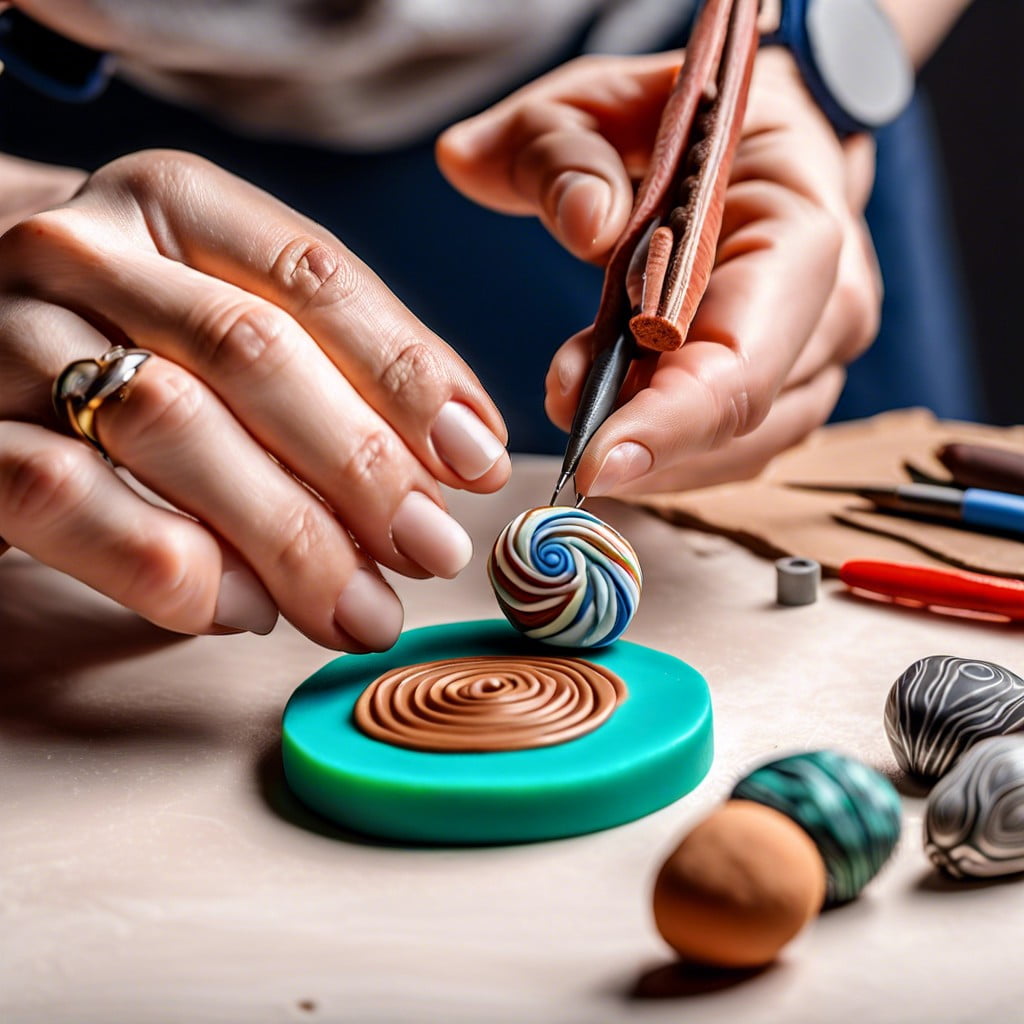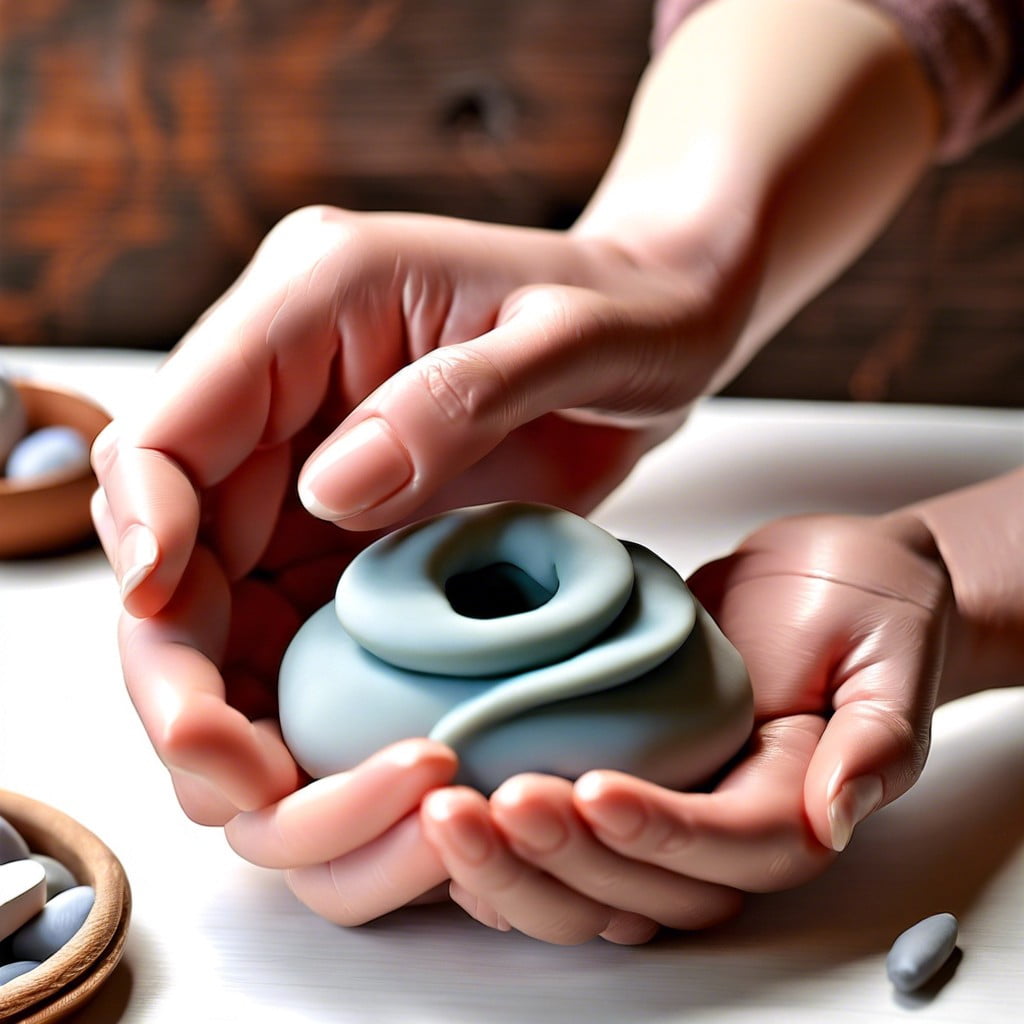Because polymer clay often hardens over time, learning to soften it can prolong its usability and enhance your craft projects.
Discover the art of bringing firm, unyielding polymer clay back to a pliable state perfect for your crafting needs. If your polymer clay has turned stubborn and hard to manipulate, fear not. This article guides you through practical tips, such as the pinch test to gauge the clay’s softness and various simple techniques to warm and condition the clay, including the use of your body heat, a warm surface, or the plastic bag method.
Learn the art of kneading to evenly distribute warmth and soften the clay, how to blend different clay textures to achieve the ideal consistency, and the effective use of commercial clay softeners. Step into the world of easy-to-mold polymer clay with our clear, step-by-step solutions detailed within.
Key takeaways:
- Pinch test to assess clay’s firmness
- Warm clay with body heat, warm surface, or plastic bag method
- Knead clay by hand to increase temperature and soften it
- Mix softer clay with firmer clay for ideal texture
- Use commercial clay softeners to rejuvenate firm clay
Assessing the Firmness of Your Polymer Clay

Before jumping into softening techniques, it’s important to gauge the stiffness of your polymer clay. Fresh out of the package, clay should be firm but pliable. If you’re struggling to mold it with ease, it’s too hard.
Perform a simple pinch test: press a thumbnail into the clay. If the indentation is smooth without cracks, your clay is workable. Notice any crumbles or resistance? That’s your cue it needs softening.
Room temperature can affect clay texture, so let it sit for a few minutes to reach ambient conditions. This initial assessment guides your approach to restore the clay’s suppleness, ensuring you don’t overwork or underwork the material.
Warming Polymer Clay to Improve Malleability

Polymer clay becomes more pliable as it absorbs heat, a quality intrinsic to its composition. To achieve this malleability without commencing the actual curing process, one can gently warm the clay. Here are some safe methods for doing so:
- Body Heat: Simply holding polymer clay in your hands can transfer enough warmth to soften it slightly. Press and flatten the clay between your palms for a few moments.
- Warm Surface: Place the clay on a surface that’s been warmed by sunlight or on a mildly heated craft mat. Avoid direct heat sources like stovetops that can prematurely bake the clay.
- Plastic Bag Method: Put the clay in a sealable plastic bag and submerge it in warm (not hot) water for approximately 10 minutes; ensure the water temperature is not high enough to cook the clay.
- Food Warmer: Utilize an electric food warmer set to a low temperature to gradually increase the clay’s temperature.
Remember, excessive heat can trigger the curing process, so moderation is key. Monitor the clay, and remove it from the heat once it’s softened to your preference.
Kneading By Hand to Soften Polymer Clay
Roll up your sleeves and get ready to give those hand muscles a workout—kneading is a simple yet effective way to revive stiff polymer clay.
Begin by sectioning the clay into smaller, more manageable pieces. This will decrease the effort needed and help protect your hands from strain.
Warm the pieces in your hands, gently squishing and rolling them between your palms. You’re not just moving the clay around; the heat from your hands is slowly increasing the clay’s temperature, making it more pliable.
As the clay softens, start to press the pieces together, blending them into a larger mass. If the clay resists, be patient.
You can flatten it with your fingers or roll it with a brayer to help soften it further. Keep at it, and with persistence, the clay will become easier to manipulate.
Your reward will be a smooth, soft polymer clay ready for your creative endeavors. Remember, this method requires time and effort, but it often strengthens the bond with your material as you prepare it for your masterpiece.
Incorporating Softer Polymer Clay Into Firmer Clay
Mixing differing consistencies of polymer clay is an efficient method to achieve an ideal texture for sculpting. Start with equal parts of your firm clay and a softer, more pliable brand or batch. Slice both clays into small pieces to ensure a uniform combination.
As you blend them together, the oils from the softer clay gradually condition the firmer one. Roll, fold, and twist the two clays using your hands or on a flat surface, applying consistent pressure. This will help distribute the plasticizers evenly.
If the clay is still too tough, you can add a bit more of the softer clay incrementally. Be patient with this process as it may take several minutes of kneading to homogenize the mixture. Once combined, your clay should exhibit a rejuvenated and workable consistency, ready for your creative endeavors.
Utilizing Commercial Polymer Clay Softeners
Commercial clay softeners are specially formulated to rejuvenate firm polymer clay. Add a few drops or a small amount of the softener to your clay and begin to knead it thoroughly. This process evenly distributes the softener, breaking down the stiff polymers to restore pliability.
When using these softeners, it’s important to start with a small quantity; you can add more as needed. Over-softening can lead to a sticky, unmanageable texture. Always read and follow the manufacturer’s instructions for the best results.
Some softeners also double as a clay thinner for use in techniques requiring a more fluid consistency. It’s worth noting that certain brands of clay might work best with their proprietary softeners, so keep brand compatibility in mind when making a purchase.
Using a Clay Conditioning Machine
A clay conditioning machine, often known as a pasta machine, streamlines the softening process while ensuring consistent results. Here are key points to consider when using the machine:
- Start with thin slices of your firm polymer clay to reduce strain on both the clay and the machine.
- Gradually increase the thickness settings as the clay becomes more pliable with each pass through the rollers.
- Fold the clay in half after each roll and insert the folded edge first to help eliminate air bubbles.
- Lightly dust the clay with cornstarch if it sticks, but avoid excessive use to maintain the clay’s properties.
- Regularly clean the machine to prevent old clay from mixing with your new batch, which could affect the softening process.
- If manual cranking is challenging, look for a motor attachment to make the task easier and more efficient.
Remember, patience is key. Run the clay through multiple times until the desired softness is achieved.
Preventing Polymer Clay From Hardening
Maintaining the pliability of polymer clay is crucial to ensure it’s ready to use when you need it. Here are a few tips to help prevent your clay from hardening:
1. Proper Storage: Always wrap your clay in wax paper, plastic wrap, or a plastic bag to protect it from air exposure. For additional protection, store it in an airtight container. This shields the clay from environmental factors that can speed up the hardening process.
2. Temperature Control: Store your polymer clay in a cool, dark place. Excessive heat can inadvertently begin the curing process, making the clay unusable, while direct sunlight can cause it to partially cure and change colors.
3. Moisture Balance: If you live in an exceptionally dry climate, consider lightly misting the storage area with water to prevent the clay from drying out; just ensure it doesn’t come into direct contact with the clay.
4. Avoid Contaminants: Keep your clay away from solvents, perfumes, and cleaners that can react with the polymer and affect its consistency.
By following these steps, your clay should remain workable and soft for whenever creativity strikes.
Troubleshooting Common Polymer Clay Softening Issues
If your polymer clay isn’t softening despite your efforts, consider these common issues:
- Insufficient Kneading: Polymer clay requires adequate working to become pliable. Continue kneading for a few more minutes to see if it softens.
- Old or Partially Cured Clay: Clay that has been stored improperly or is old may not respond well to softening techniques. In such cases, mixing with fresh clay or using a softener might help.
- Room Temperature: If your working environment is too cold, the clay can remain stiff. Try warming the material by holding it in your hands or placing it in a warm spot briefly.
- Too Much Softener Added: Excessive softener can make the clay sticky and unworkable. If this occurs, mix in small amounts of fresh clay to restore the consistency.
- Type of Polymer Clay: Some polymer clays are inherently firmer than others. Understanding your brand’s properties can guide you towards the right softening method.
If issues persist, consider reaching out to fellow crafters for advice or consult the manufacturer’s instructions for specific softening tips related to the brand you’re using.
How to Keep Polymer Clay Soft (Prevention)
Storing your polymer clay correctly is crucial to maintaining its softness. Here are some tips:
- Cool, Dark Places: UV light and heat can prematurely cure clay. Place it in a cool, dark environment away from windows and heat sources.
- Airtight Containers: Polymer clay should be stored in zip-lock bags or containers with tight-fitting lids to keep out air, which can dry out the clay.
- Separate Colors: To prevent color transfer and potential hardening, store different colors separately.
- Avoid Friction: Reduce the clay’s contact with itself or other objects within its storage to minimize the curing process that friction can initiate.
- Dust-Free Environment: Keeping clay away from dust preserves its quality and prevents it from becoming gritty.
By following these simple storage guidelines, you help ensure your polymer clay remains workable for your next project.
FAQ
How do you soften hard polymer clay?
To soften hard polymer clay, incorporate a drop of mineral oil, kneading after each addition, until achieving a workable texture.
Can you microwave polymer clay to soften it?
No, microwaving polymer clay is not advisable, but you can soften it by kneading with your hands or by immersing it in hot water inside a plastic bag.
Can you add water to polymer clay to soften it?
Polymer clay should be softened through manipulation with hands or tools such as a marble rolling pin or a pasta roller, not by adding water.
Does Vaseline soften polymer clay?
Yes, Vaseline can be used to soften polymer clay.
Does the application of heat from a hairdryer assist in softening polymer clay?
Yes, the application of heat from a hairdryer can assist in softening polymer clay.
Can you leverage baby oil to enhance the flexibility of polymer clay?
Yes, adding baby oil to polymer clay can improve its flexibility by preventing it from drying out or becoming brittle.
Is a clay softener necessary for rejuvenating older, hardened polymer clay?
Yes, a clay softener is necessary for rejuvenating older, hardened polymer clay, as it aids in restoring malleability and preventing cracking.
Recap




